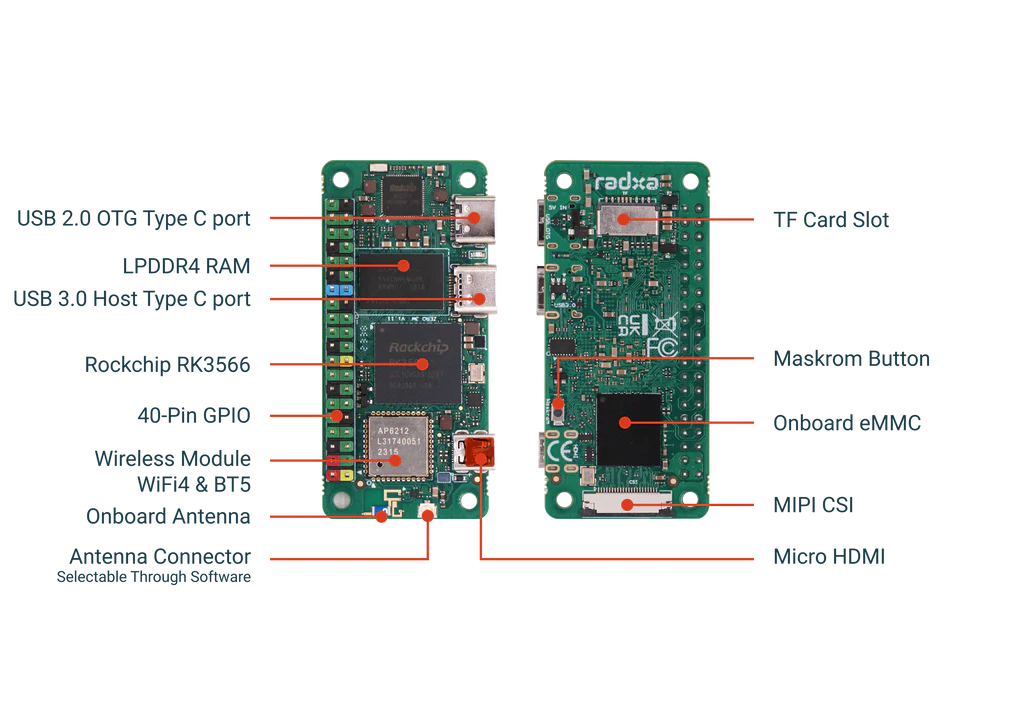$15 Radxa Zero 3 W Offers More Processing Power in Your Pocket
Small in size, great in power?

The Raspberry Pi Zero 2 W has been hard to come by since it was released in 2021. Providing the power of the Raspberry Pi 3B+ in the Zero form factor, the Zero 2 W was a decent board for projects. But if you can't buy it, then others will step up to the plate, and Radxa is one of them. Its new Zero 3 W, starting from $15, features a Rockchip RK3566 SoC and provides up to 8GB of RAM, making it an attractive alternative to the Zero 2 W.



| SoC | Rockchip RK3566. Quad-core Arm Cortex A55 CPU running at 1.6 GHz |
| Row 1 - Cell 0 | Arm Mali G52-2EE GPU |
| RAM | 1/2/4/8 GB LPDDR4 |
| Storage | 8/16/32/64 GB eMMC, Micro SD card |
| Ports | Micro HDMI (1080p/60fps) |
| Row 5 - Cell 0 | USB 2.0 OTG Type C, USB 3.0 Type C Host |
| Connectivity | Wi-Fi 4 (802.11 b/g/n) and Bluetooth 5 (on board antenna and uFL connector) |
| GPIO | 40 pin GPIO |
| Row 8 - Cell 0 | 5 x UART, 1 x SPI, 2 x I2C, 1 x PCM/I2S, 6 x PWM, 28 x Digital IO |
| Power | USB C power, 5V via GPIO pins |
| Dimension | 65 x 30mm |
For your $15, you get a 1GB model with no eMMC storage, but with a micro SD card we can have all the storage that you're likely to need. The slot supports up to a 128GB micro SD card. Pay $21 and you get 8GB of eMMC storage for your Linux based OS. Right now you have a choice of Debian and Ubuntu OS, which can be run headless or with a lightweight desktop (XFCE, LXDE, etc.). If you blow the budget, for $65 you can pick up a model with 8GB of LPDDR4 RAM and 64GB of eMMC. That would be a powerful pocket server when you consider that there is a quad-core Arm A55 CPU that's underclocked to run at 1.6 GHz to keep things more efficient. This CPU can run at up to 2 GHz, but more typically runs at around 1.8 GHz. Underclocking the CPU for the Zero 3 W may be a means to keep it cool, but you can also tweak the settings and give yourself a free speed-boost. Just be sure you have a solution in place to keep thermals in check.
The Micro HDMI port choice is great for saving space, but it breaks compatibility with any cases designed for the Raspberry Pi Zero. The official Pi Zero form factor uses a mini HDMI port. Another compatibility break is using USB-C in the place of micro USB. We fully support the use of USB-C in place of micro USB. The latter connector is fragile, and we always end up trying to insert it the wrong way. USB-C is a strong connector and you can't get it wrong!
There's no space for an Ethernet port, so your networking is all wireless. Don't expect hyper-fast Wi-Fi 6 / 7. You get Wi-Fi 4 (802.11 b/g/n), which is good enough for most projects.
The elephant in the room is the GPIO. It may have 40 pins, but don't expect compatibility with the best Raspberry Pi HATs. Your favorite hat will need software, and the Radxa Zero 3 W may not be supported. If you are using common components, such as I2C, SPI, Digital IO, then you should be good. The GPIO should be accessible via the Linux OS, and there may be support via programming languages like Python and C.
At the time of writing, all board options are out of stock but you can sign up for notifications.
Get Tom's Hardware's best news and in-depth reviews, straight to your inbox.

Les Pounder is an associate editor at Tom's Hardware. He is a creative technologist and for seven years has created projects to educate and inspire minds both young and old. He has worked with the Raspberry Pi Foundation to write and deliver their teacher training program "Picademy".
-
ustix Is it really wifi 4? The radxa zero 2 has wifi 5 already, why would they make something worse for the new version?Reply -
PRSXFENG Reply
Seems like it, the AP6212 module is WiFi 4 onlyustix said:Is it really wifi 4? The radxa zero 2 has wifi 5 already, why would they make something worse for the new version?
I guess it's for cost cutting reasons to hit the $15 price point? -
ustix Reply
There is more option, and for radxa zero there is wifi 5 but for this new thing there is no such option even for the $46 one. So that is not a solution.PRSXFENG said:Seems like it, the AP6212 module is WiFi 4 only
I guess it's for cost cutting reasons to hit the $15 price point?